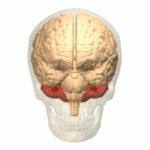We recently reported on new technology that enables amputees and other disabled people to control robotic arms with their brains. Since then, scientists at the University of Missouri, Columbia have been further investigating how the human brain interacts with such robotic limbs and the findings are fascinating.
A simple hand motion, such as grasping an object, actually involves a complex set of brain functions. First, the brain receives and processes visual signals. Next, other areas of the brain use these signals to control the hands as they reach for and grasp the desired object. Even though the process is complex, people such as this paralyzed woman have been able to manipulate robotic arms with little or no training.
The latest research suggests that the cerebellum, a part of the brain that has changed very little over time, is the key. The MU researchers believe that understanding how the brain interacts with robotic prosthetics will lead to better rehabilitation resources for amputees, stroke victims, and other disabled persons.
This is your brain on robotics:
The cauliflower-shaped cerebellum (Latin for “little brain”), is an ancient structure in your brain at the lower rear of your skull. Even though it’s small, it contains more neurons than the rest of the brain combined. This “little brain” is important for controlling movement as well as higher cognitive functions. The cerebellum doesn’t initiate movement, but makes it possible to carry out a motion, such as grasping.


“We live in a world of advanced technology in which a button can move a crane or open a door,” says Scott Frey, professor of psychological sciences in the College of Arts and Science and director of the Brain Imaging Center at MU. “For those with disabilities, assistive technologies, such as robotic arms or sensors inserted in the brain, make it possible to accomplish actions like grasping with the press of a button or directly through brain activity; however, little is known about how the human brain adapts to these technologies.”
The study uncovered new evidence of the brain’s ability to be quickly conditioned to associate a movement with its consequence. The subjects of the study were given two buttons that, when pressed, gave two different results. Frey explains: “Pressing a button is a very simple act that does not naturally result in grasping. Nevertheless, after subjects learned that pressing one button would result in grasping objects with a robotic arm, this same movement resulted in a dramatically different pattern of brain activity than pressing an identical button known by them to have no effect on the robot’s behavior.”
Researchers noted a dramatic increase in localized activity in the cerebellum when the button that produced the grasping motion was pressed. Frey suggests that the findings point to the importance of the cerebellum as a potential target for brain-control technology.
This research was funded in part by the Army Research Laboratory’s Research Office, the National Institute of Health, and the National Institute of Neurological Disease. The study, “Grasping with the press of a button: grasp-selective responses in the human anterior intraparietal sulcus depend on nonarbitrary causal relationships between hand movements and end-effector actions,” is published in the Journal of Cognitive Neuroscience.
Photo of Frey courtesy of MU News Bureau.

